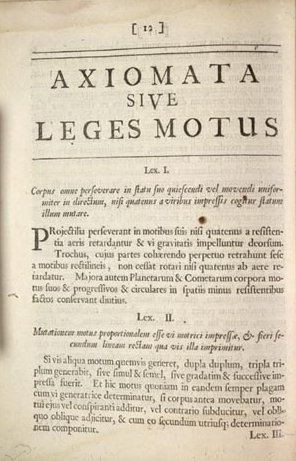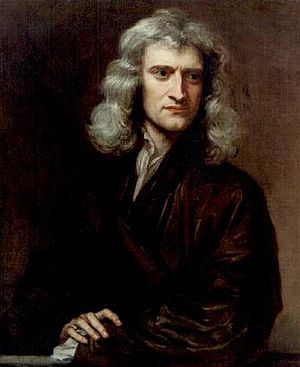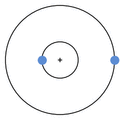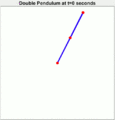Newton's laws of motion facts for kids
Isaac Newton (1642–1727) was a brilliant scientist who studied how things move. He came up with three important rules, called laws, that help us understand motion. Scientists have tested these laws many times, and they always seem to be true! These laws are super important for understanding everything from how a ball rolls to how rockets fly into space.
Contents
Newton's First Law: The Law of Inertia
Newton's first law is all about how objects behave when forces act on them. It says:
- If something is still, it will stay still. If something is moving, it will keep moving at the same speed and in the same direction. This will happen until a resultant force pushes or pulls it.
What does "uniform velocity" mean? It means an object is moving at a steady speed without changing its direction. Think of a car driving perfectly straight at 50 miles per hour.
What is a "resultant force"? This means the pushes and pulls on an object are not balanced. If you push a box, and someone else pushes it just as hard in the opposite direction, the forces are balanced, and the box won't move. But if your push is stronger, there's a resultant force, and the box will move.
So, the first law tells us two main things:
- A still object will only start to move if an unbalanced force acts on it.
- A moving object will only speed up, slow down, or change direction if an unbalanced force acts on it.
Let's look at an example. Imagine a table sitting on the floor. It stays still, right? That's because the forces on it are balanced. Gravity pulls the table down, but the floor pushes it up with an equal force. Since these forces are balanced, the table doesn't move.
Now, think about a ball rolling across a flat floor. It eventually slows down and stops. Why? Because of friction and air resistance. These are forces that push against the ball, slowing it down. If there were no friction or air resistance (like in outer space), a ball would keep rolling forever in a straight line once it started moving!
Newton's Second Law: Force, Mass, and Acceleration
Newton's second law explains how force, mass, and acceleration are connected. It states:
- The resultant force on an object is equal to its mass multiplied by its acceleration.
This law gives us a way to calculate force. It tells us that:
- If you apply a bigger force to an object, it will accelerate more (speed up faster).
- If an object has more mass (is heavier), it will accelerate less when the same force is applied. Think about pushing a small toy car versus pushing a real car!
We can write this as a simple formula:
Here, F stands for force, m stands for mass, and a stands for acceleration.
For example, your weight is a force caused by Earth's gravity. We can calculate weight using a similar idea:
In this formula, W is your weight, m is your mass, and g is the acceleration due to gravity. On Earth, g is about 9.8 meters per second squared. This means that if you drop something, its speed increases by 9.8 meters per second every second!
Newton's Third Law: Action and Reaction
Newton's third law is often stated as:
- For every action, there is an equal and opposite reaction.
This means that forces always come in pairs. When one object pushes on another, the second object pushes back on the first with the same amount of force, but in the opposite direction.
Let's look at some examples:
- When you kick a football, your foot pushes the ball forward. At the same time, the ball pushes back on your foot with an equal force, which is why you feel it!
- Think about a fish swimming. The fish pushes water backward with its fins. In return, the water pushes the fish forward, making it move through the water. The push on the water is the "action," and the push back on the fish is the "reaction."
- When a car drives, its wheels spin and push the road backward. The road then pushes the wheels (and the car) forward. This "action-reaction" pair is what makes cars move!
Forces always happen in these pairs. You can't have a single force acting alone.
Related pages
Images for kids
-
Newton's laws of motion, combined with his law of gravity, allow the prediction of how planets, moons, and other objects orbit through the Solar System, and they are a vital part of planning space travel. During the 1968 Apollo 8 mission, astronaut Bill Anders took this photo, Earthrise; on their way back to Earth, Anders remarked, "I think Isaac Newton is doing most of the driving right now."
-
Rockets work by producing a strong reaction force downwards using its rocket engine. This pushes the rocket upwards, without regard to the ground or the atmosphere.
-
A bouncing ball photographed at 25 frames per second using a stroboscopic flash. In between bounces, the ball's height as a function of time is close to being a parabola, deviating from a parabolic arc because of air resistance, spin, and deformation into a non-spherical shape upon impact.
-
Two objects in uniform circular motion, orbiting around the barycenter (center of mass of both objects)
-
Rockets, like the Space Shuttle Atlantis, work by propelling matter in one direction to push the craft in the other. This means that the mass being pushed, the rocket and its remaining onboard fuel supply, is constantly changing.
-
Emmy Noether (1882–1935), who proved a celebrated theorem that relates symmetries and conservation laws, a key development in modern physics that is conveniently stated in the language of Lagrangian or Hamiltonian mechanics.
-
A simulation of a larger, but still microscopic, particle (in yellow) surrounded by a gas of smaller particles, illustrating Brownian motion.
-
Page 157 from Mechanism of the Heavens (1831), Mary Somerville's expanded version of the first two volumes of Laplace's Traité de mécanique céleste. Here, Somerville deduces the inverse-square law of gravity from Kepler's laws of planetary motion.
See also
 In Spanish: Leyes de Newton para niños
In Spanish: Leyes de Newton para niños

















